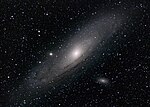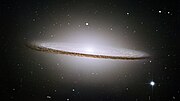Star formation is the process by which dense regions within molecular clouds in interstellar space, sometimes referred to as "stellar nurseries" or "star-forming...
48 KB (5,537 words) - 16:11, 19 July 2024
through fusion, they inexorably cool down after their formation. Consequently, a given neutron star reaches a surface temperature of one million degrees...
114 KB (13,801 words) - 16:50, 9 August 2024
regions. Such feedback effects, from star formation, may ultimately disrupt the cloud and prevent further star formation. All stars spend the majority of...
146 KB (16,353 words) - 19:43, 1 August 2024
clustered nature of star formation by treating star clusters as the fundamental unit of star formation. This approach permits the growth of star particles by...
45 KB (5,578 words) - 01:14, 29 July 2024
formation process. The observation of binaries consisting of stars not yet on the main sequence supports the theory that binaries develop during star...
67 KB (8,092 words) - 01:49, 4 August 2024
Nebular hypothesis (redirect from Planet formation)
not well known. Thus the formation of planetary systems is thought to be a natural result of star formation. A Sun-like star usually takes approximately...
75 KB (9,132 words) - 21:54, 8 August 2024
Galaxy (section Formation and evolution)
heavy elements, eventually allowing the formation of planets. Hubble eXtreme Deep Field (XDF) Star formation rates in galaxies depend upon their local...
158 KB (15,910 words) - 07:11, 12 August 2024
Cosmology (redirect from Bursty star formation)
cosmological constant. Absolute time and space Big History Earth science Galaxy formation and evolution Illustris project Jainism and non-creationism Lambda-CDM...
51 KB (3,260 words) - 14:03, 5 August 2024
Starburst galaxy (redirect from Star burst galaxies)
exceptionally high rate of star formation, as compared to the long-term average rate of star formation in the galaxy, or the star formation rate observed in most...
19 KB (2,063 words) - 17:11, 7 August 2024
Molecular cloud (section Star Formation)
(if star formation is occurring within), is a type of interstellar cloud, the density and size of which permit absorption nebulae, the formation of molecules...
34 KB (3,787 words) - 12:36, 1 August 2024
parent star Kepler 452 7.98 billion years (5.82 Gya): Formation of Mira or Omicron ceti, binary star system. Formation of Alpha Centauri Star System,...
36 KB (4,992 words) - 18:52, 9 August 2024
Elliptical galaxy (section Star formation)
clusters. Star formation activity in elliptical galaxies is typically minimal; they may, however, undergo brief periods of star formation when merging...
17 KB (1,895 words) - 19:20, 7 August 2024
Triangulum Galaxy (section Star formation)
"The Star Formation History of the Local Group". In F. Favata; A. Kaas; A. Wilson (eds.). Proceedings of the 33rd ESLAB symposium on star formation from...
48 KB (5,097 words) - 19:35, 29 July 2024
Andromeda Galaxy (section Formation and history)
sequence" (galaxies that lack star formation). Star formation activity in green valley galaxies is slowing as they run out of star-forming gas in the interstellar...
110 KB (10,777 words) - 02:39, 9 August 2024
Whirlpool Galaxy (section Star formation)
period of enhanced star formation. The present efficiency of star formation, defined as the ratio of mass of new stars to the mass of star-forming gas, is...
29 KB (3,023 words) - 03:28, 22 July 2024
Messier 100 (section Star formation)
spots. Messier 100 is considered a starburst galaxy with the strongest star formation activity concentrated in its center, within a ring – actually two tightly...
10 KB (1,085 words) - 09:17, 24 February 2024
Leo I (dwarf galaxy) (section Star formation)
major increase (accounting for 70% to 80% of its population) in its star formation rate between 6 Ga and 2 Ga (billion years ago). There is no significant...
8 KB (891 words) - 22:23, 2 December 2023
leading to the disruption of a star cluster. Most young embedded clusters disperse shortly after the end of star formation. The open clusters found in the...
22 KB (2,596 words) - 12:03, 28 June 2024
Nebula (redirect from Nebulous star)
Nebulae are often star-forming regions, such as in the Pillars of Creation in the Eagle Nebula. In these regions, the formations of gas, dust, and other...
21 KB (2,865 words) - 00:06, 6 August 2024
Local Bubble (section Impact on star formation)
for the formation of all young, nearby stars. These new stars are typically in molecular clouds like the Taurus molecular cloud and the open star cluster...
20 KB (2,149 words) - 11:40, 26 July 2024
gas found in star formation regions. However, if star formation cannot be found in LINERs, then this definitively excludes star formation as powering LINER...
12 KB (1,317 words) - 10:17, 16 June 2024
Stellar population (redirect from Population III star)
were later shown to be very important and were possibly related to star formation, observed kinematics, stellar age, and even galaxy evolution in both...
35 KB (3,548 words) - 00:54, 12 August 2024
small dark nebulae containing dense cosmic dust and gas from which star formation may take place. Bok globules are found within H II regions, and typically...
9 KB (847 words) - 03:38, 16 July 2024
Messier 65 (section Star formation)
of authors. The galaxy is low in dust and gas, and there is little star formation in it, although there has been some relatively recently in the arms...
6 KB (491 words) - 06:59, 30 December 2023
Spiral galaxy (redirect from Halo star)
center into the galactic disc. The spiral arms are sites of ongoing star formation and are brighter than the surrounding disc because of the young, hot...
30 KB (3,630 words) - 23:48, 8 August 2024
Radiation pressure (section Star formation)
astronomy, star formation includes the study of the interstellar medium and giant molecular clouds (GMC) as precursors to the star formation process, and...
40 KB (5,289 words) - 15:21, 14 July 2024
Open cluster (redirect from Cluster formation)
have been found only in spiral and irregular galaxies, in which active star formation is occurring. Young open clusters may be contained within the molecular...
51 KB (6,261 words) - 23:07, 28 July 2024
Hall effect (section Relationship with star formation)
Although it is well known that magnetic fields play an important role in star formation, research models indicate that Hall diffusion critically influences...
33 KB (3,777 words) - 11:04, 7 May 2024
significant population of massive supergiants and Wolf–Rayet stars from star formation in the region around 1 million years ago. The core stars are a small...
48 KB (4,922 words) - 22:08, 17 July 2024





























